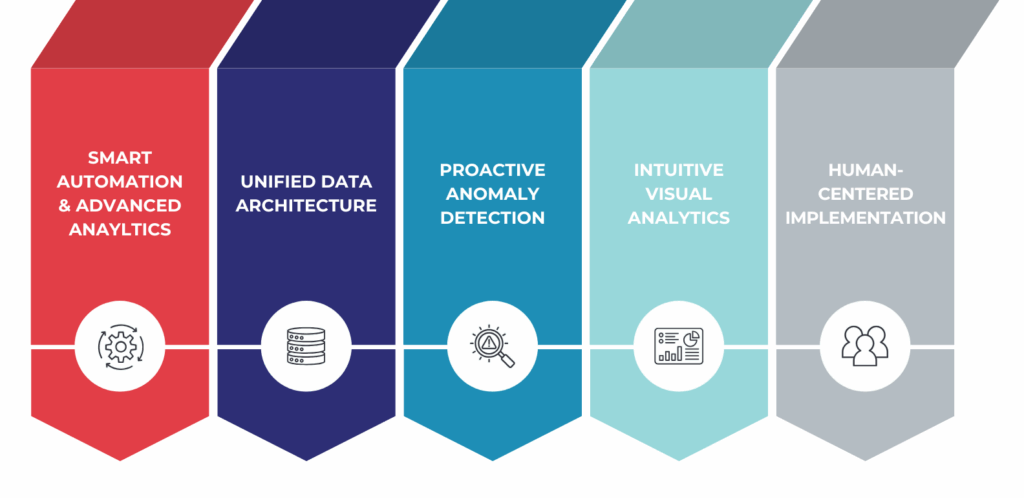For federal agencies, fraud is an ongoing and serious concern. As fraud strategies become increasingly complex, agencies must modernize to protect taxpayer dollars while also meeting their missions. In this regard, artificial intelligence (AI) becomes a non-negotiable service.
By enhancing human expertise with AI and data analytics, agencies can proactively detect and prevent fraud.
AI powered fraud prevention may sound daunting. But, it can be broken down in five easy and effective foundational pillars:
- Smart Automation & Advanced Analytics
- Unified Data Architecture
- Proactive Anomaly Detection
- Intuitive Visual Analytics
- Human-Centered Implementation

In this three-part series we’ll dive into these five components of a modernized approach to fraud detection and prevention. With proper implementation, agencies can better manage vast amounts of data across legacy systems.
We’ll start with the first pillar: Smart Automation & Advanced Analytics.
Laying a Foundation for Sustainable AI Implementation
Natural language processing (NLP) and deep neural networks (DNN ), components of AI solutions, are well-suited for uncovering subtle patterns and relationships that suggest fraud. Combining these capabilities with smart automation and advanced analytics helps agencies:
- Analyze and comprehend large amounts of data
- Enable speed, consistency, and pattern recognition
A human conducting a manual review of the same data cannot match these results.
AI-powered risk scoring algorithms allows for automatic evaluation and prioritization of documents or cases. Risk scoring may be based on potential impact, urgency, or relevance. This means critical items receive timely attention, accelerating decision-making and improving operational efficiency.
AI in Action: Protecting a $1 Trillion Portfolio
The positive impact of smart automation and analytics is on full display at the U.S. Department of Health and Human Services (HHS), which implemented an AI-powered fraud detection system. As the largest grant-making organization in the federal government, the HHS Office of the Inspector General (OIG) is tasked with oversight of a portfolio worth more than $1 trillion. With such a vast portfolio—one comprised of over 900,000 contracts and grants—fraud can slip through the cracks. That’s where we come in.
HHS OIG partnered with Excella to develop the Contracts and Grants Analytics Portal (CGAP)—an advanced analytics tool that streamlines research by providing a single access point for data regarding grants, contracts, principal investigators, and single audit findings. We’ll talk more about the importance of a unified data architecture in our next post, but it’s worth noting that we can only apply smart automation and advanced analytics when data isn’t siloed. By integrating data from 14 sources, CGAP eliminates the need for users to access multiple systems or request more data to complete a report.
The Nuts and Bolts and AI-Driven Fraud Detection
This approach was an indispensable tool for HHS OIG. It automated the identification of suspicious patterns and fraud indicators, making it easier to elevate high-risk grants and contracts to investigators. Thanks to the system, auditors and investigators no longer have to review upward ten thousand pages of documentation, eliminating about 4,000 work hours annually.
More specifically, CGAP:
- Pinpoints grant recipients with elevated risk
- Identifies trends within HHS programs to support audits and evaluations
- Evaluates contract payments and grant drawdowns to identify unusual behaviors
- Exposes hidden relationships by analyzing data from different government databases
- Tracks risk patterns and notifies staff of important changes

In one instance, CGAP identified a biotech company that was fraudulently obtaining small business research grants. This enabled the agency to intervene, leading to a $10 million settlement . In another case, it was discovered that falsified research data was used to secure funding. Smart automation and advanced analytics led to the recovery of $16 million.
Enhancing Human Expertise, Not Replacing It
Smart automation helps stay on top of fraud given the ever-growing volumes of data agencies handle. Yet, solutions like CGAP aren’t meant to replace human expertise. Instead, these systems make human judgment more powerful by directing investigators to high-risk behaviors and by freeing them up for higher-value work.
AI is not a silver bullet, but an enabler of smarter human decisions. The time is now to move from reactive to proactive fraud detection.
In our next post, we’ll dive into the technical backbone of fraud detection, focusing on how a unified data architecture and proactive anomaly detection, including data consolidation across silos, scalable cloud pipelines, similarity scoring, and early warning systems help agencies shift from reactive to proactive oversight.
If you want to learn more about how smart automation and advanced analytics can help your agency, get in touch today. We’re passionate about applying AI, data analytics, and human-centered solutions to prevent fraud, waste, and abuse. We would love to help you see the same results as HHS OIG.